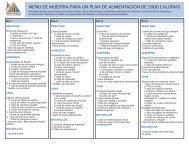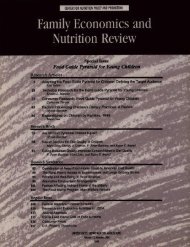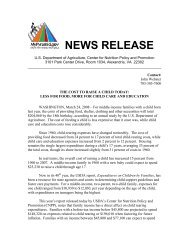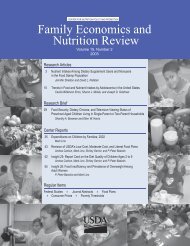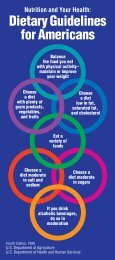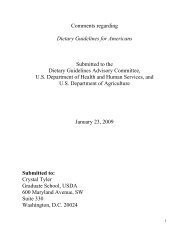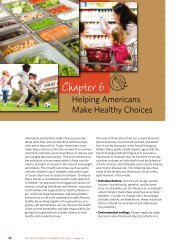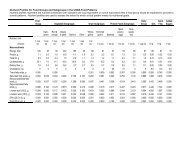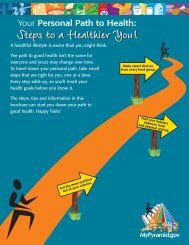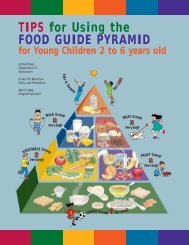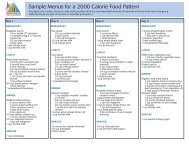Elderly Nutrition - Center for Nutrition Policy and Promotion - US ...
Elderly Nutrition - Center for Nutrition Policy and Promotion - US ...
Elderly Nutrition - Center for Nutrition Policy and Promotion - US ...
Create successful ePaper yourself
Turn your PDF publications into a flip-book with our unique Google optimized e-Paper software.
greens were a good source of dietary<br />
calcium. One participant commented,<br />
“I didn’t know [turnip greens] had<br />
calcium. I know I love them.” In<br />
addition to greens, participants<br />
seemed surprised to learn about the<br />
high calcium content of many foods,<br />
such as sardines with bones, prunes,<br />
broccoli, spinach, <strong>and</strong> tofu. Although<br />
the basis of such confusion may be lack<br />
of nutrition knowledge, the confusion<br />
may also relate to how health care<br />
professionals organize nutrition<br />
knowledge. It is possible that the issue<br />
of food categories in terms of nutrients<br />
may represent a difference in the<br />
organizational schema of nutritional<br />
sciences based on nutrients, while that<br />
of the participants’ knowledge may be<br />
based on other factors. Krall, Dwyer,<br />
<strong>and</strong> Coleman (1988) said it this way:<br />
[A] person’s memory is likely<br />
to follow personal schemes<br />
such as food combinations,<br />
time, location, etc. The<br />
categorization scheme, such<br />
as nutrient-related groups, is<br />
not well understood by most<br />
lay persons, [<strong>and</strong> is] there<strong>for</strong>e,<br />
alien to the manner in which<br />
[their] in<strong>for</strong>mation was stored,<br />
[<strong>and</strong>] imposes an arbitrary<br />
structure which potentially<br />
leads to inefficient recall.<br />
In addition, concerns about food<br />
h<strong>and</strong>ling <strong>and</strong> sanitation practices of<br />
food service establishments served<br />
as a deterrent to ordering milk as a<br />
beverage when eating out.<br />
“Now, I wouldn’t order milk<br />
out—because I use to work at<br />
a restaurant . . . . If they bring<br />
[milk] to me in a glass, I<br />
wouldn’t drink it. [Researcher:<br />
How come?]. . . Well, we had<br />
a keg. And, everyone would<br />
dip their h<strong>and</strong> down in that<br />
keg, <strong>and</strong> they’d want the<br />
employees to drink that milk,<br />
. . . Well, we could get milk<br />
[from] the dining room, but<br />
the other help had to get milk<br />
from . . . that keg, <strong>and</strong> I didn’t<br />
think that was right.”<br />
Health reasons, disease state, <strong>and</strong> food<br />
intolerance. Many of the participants<br />
were concerned about health <strong>and</strong><br />
disease-related issues. They were<br />
especially concerned with heart<br />
disease, high blood pressure, high<br />
cholesterol, <strong>and</strong> arthritis. Previous<br />
research also found similar health<br />
concerns in rural African-American<br />
elderly (Lee, Templeton, Marlette,<br />
Walker, & Fahm, 1998; Wallace, Fox, &<br />
Napier, 1996). As one participant in the<br />
1996 study commented: “I drink a little<br />
milk, . . . I can’t h<strong>and</strong>le milk too good<br />
unless I’m at home.” Thus, participants<br />
in the 1996 study sometimes tied these<br />
concerns to food restrictions, especially<br />
when their physician instructed them<br />
to eliminate certain foods from their<br />
diets. The participants reported being<br />
educated by their physician or nurse<br />
(none mentioned a dietitian) about<br />
which foods to avoid. Participants often<br />
followed medical recommendations to<br />
avoid or restrict a food group that was a<br />
calcium source without any instruction<br />
on how to replace the calcium in their<br />
diet.<br />
In terms of lactose intolerance,<br />
symptoms mentioned included<br />
flatulence, <strong>and</strong> stomach problems.<br />
Participants also mentioned that dairy<br />
products, such as milkshakes, were<br />
“too rich <strong>for</strong> the system,” although this<br />
could be related to the fat or sugar<br />
content. Generally, participants did not<br />
specifically mention dietary strategies<br />
<strong>for</strong> managing lactose intolerance, such<br />
as consuming yogurt or acidophilus<br />
milk or using lactase tablets. However,<br />
one participant mentioned the lack of<br />
lactose-free products as a barrier to<br />
purchasing dairy products in food<br />
service establishments.<br />
The focus group participants<br />
expressed an interest in all types<br />
of educational media including<br />
direct mail, television, radio,<br />
newspapers, <strong>and</strong> magazines.<br />
2003 Vol. 15 No. 1 9



